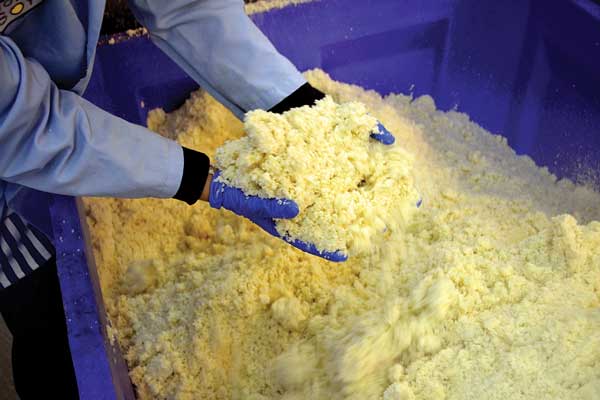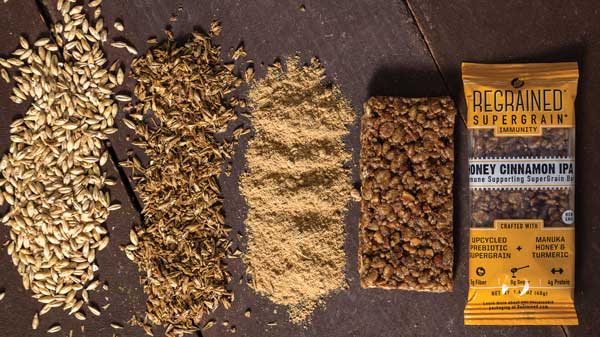Solving the Food Waste Disgrace
PROCESSING
Food waste is a hot topic, and food processing is one important means of addressing this critical challenge in today’s food system. This column will provide an overview of the food waste issue, as well as categories of solutions and specific examples of how companies and researchers are addressing these challenges through innovative food processing.
 Issues and Opportunities
Issues and Opportunities
Every year, American consumers, businesses, and farms spend $218 billion, or 1.3% of gross domestic product, growing, processing, transporting, and disposing of food that is never eaten. That amounts to 52 million tons of food sent to landfill annually. In the United States, the breakout of food waste is as follows: 10% (10 million tons) of food waste is lost at the farm level, 2% (1 million tons) is wasted during manufacturing, 40% (25 million tons) is wasted by consumer-facing businesses, and 43% (27 million tons) is wasted in homes. Meanwhile, one in seven Americans is food insecure.
This critical issue is not isolated in the United States but is a global crisis that we are facing collectively as a human race. One-third of food grown annually for human consumption is never eaten, amounting to over 1 billion metric tons. Fifty-six percent of food waste is generated in developed countries, and 44% is generated in developing countries. At the same time, 800 million people around the globe, or one in nine, are starving. Worse yet, due to limited natural resources (e.g., land mass and water), predicted population growth, and increased soil depletion, there is even greater concern that we will not be equipped to meet future food demands on a national and international level. As a result, the U.S. Department of Agriculture and the United Nations have declared a state of food insecurity. An inadequate food supply is not only an issue of food security, but of food quality, safety, nutrition, and health. At the same time, the World Bank estimates that 1,520 calories per person per day are lost in North America due to food waste and between 415 and 750 calories per person per day are lost in other parts of the world. A great deal of nutrition (protein, fiber, vitamins, minerals, and antioxidants) is locked up in those lost calories. Clearly, there is opportunity juxtaposed with concerns over food waste.
A few years ago, the United States launched a federal initiative aimed at cutting food waste by 50% by 2030. Led by the Environmental Protection Agency and U.S. Department of Agriculture, a food recovery hierarchy was established, prioritizing approaches to reducing food waste. The most preferred method is source reduction, followed by feeding hungry people, feeding animals, industrial uses, composting, and ending with the lowest priority of landfill/incineration. Around the same time, a multi-stakeholder nonprofit called ReFED provided a comprehensive roadmap to reducing food waste in the United States. This roadmap provides a 27-point list of ways to address the food waste issue, including everything from standard date labeling to cold chain management to packaging to donations to value-added processing solutions. Also included in the roadmap are estimated costs, as well as the economic benefit and value of each of the 27 proposed solutions. In total, ReFED estimates that when these solutions are implemented they will generate $10 billion in economic value and save 1.8 billion meals. In addition, they will save 1.6 trillion gallons of water annually, provide $5.6 billion in annual consumer savings, and reduce greenhouse gas emissions by 18 million tons annually while increasing annual business profits by $1.9 billion.
The remainder of this column will focus on two specific processing-related solutions to the food waste issue: manufacturing line optimization and value-added processing. Many additional opportunities exist for food scientists to reduce food waste through means other than food processing; these include packaging improvements, shelf-life extension, cold chain management, and more.
Two Approaches to Waste Reduction
• Manufacturing Line Optimization. According to ReFED, manufacturing line optimization offers the ability to divert 20,000 tons of food waste valued at $1,770 per ton, saving a total of $35.4 million. In addition, it is estimated that 7 billion gallons of water will be saved and 61,000 tons of greenhouse gas emissions eliminated. Food processing equipment is unique to each food plant and product line. Optimization of equipment operating conditions, solving production line issues, and repurposing discarded food for sale or donation are approaches that contribute to these savings. Machinery performance problems, such as product blockages and mechanical mishandling, result in product damage at levels up to 2.5% to 9%, depending on the process. Poor quality production, such as underbaking or overbaking, is estimated to result in reject rates of up to 3.5%.
An example of a manufacturing line optimization that reduced waste was provided by the Food Waste Reduction Alliance in its fall 2015 report. According to the report, a move by Conagra to change the way it transitioned from one pudding flavor to another during manufacturing allowed the company to significantly reduce loss levels by creating a blended-flavor pudding product, which it donated to benefit those in need.
• Value-Added Processing. According to ReFED, value-added processing offers the ability to divert 102,000 tons of food waste valued at $2,783 per ton, saving a total of $283 million. In addition, it is estimated that 299,000 tons of greenhouse gas emissions will be eliminated and 171 million meals saved.
Innovative Food Processing Solutions
Many companies, including the following, are employing innovative, value-added food processing to reduce food waste while providing nutrition to consumers.
• Misfit Juicery. Twenty billion pounds of fruits and vegetables go unharvested or unsold each year in the United States. One business that is working toward reducing this waste is Misfit Juicery. The company has teamed up with farmers, distributors, and fresh-cut producers in a unique manner to make use of fruit and vegetable materials that would otherwise not be used, converting ugly or leftover produce into healthy and flavorful juices.
• Compass Group, USA. Working on a larger scale, Compass Group USA is converting ugly produce into meals and currently serves 8 million meals a day utilizing ugly or leftover produce from farmers that would have otherwise been wasted. The company has diverted more than 46 tons of waste in California and Washington thus far.
• Barnana. Barnana is a company working to utilize organic bananas grown in Latin America that are not suitable for the fresh market. The company works with farms all over Latin America to source imperfect bananas and process them into partially dehydrated banana snacks. In 2017 it processed more than 4 million pounds of bananas. The company also produces plantain chips.
• Monterey Mushrooms. Ultraviolet light processing was the topic of the Processing column in March 2015 and has been used to develop novel healthy food ingredients from mushroom waste materials. Novel Vitamin D supplements are currently manufactured from mushroom stalks, which were formerly waste materials. Monterey Mushrooms is one company that treats the mushroom stalks, processing them into dried mushroom powders that provide up to 40,000 International Units of vitamin D per gram and that can be added to foods or consumed as natural Vitamin D supplements.
 • ReGrained. Each year about 6 billion pounds of brewers spent grains are produced during the manufacturing of beer. Currently, this material is considered food waste and tossed into the landfill or compost. Having most of the sugar removed, brewers spent grain largely retains its high protein, fiber, and antioxidant content, making it a flavorful and nutritious food ingredient. ReGrained is using a patent-pending processing technology to convert brewers spent grain into SuperGrain flour. A 100 g sample of the flour contains on average 20 g of protein and 37 g of dietary fiber, amounts greater than those of most other flours. In addition to selling the flour, ReGrained also sells bars containing the brewers spent grain. To date, ReGrained has upcycled 41,641 pounds of brewers spent grains.
• ReGrained. Each year about 6 billion pounds of brewers spent grains are produced during the manufacturing of beer. Currently, this material is considered food waste and tossed into the landfill or compost. Having most of the sugar removed, brewers spent grain largely retains its high protein, fiber, and antioxidant content, making it a flavorful and nutritious food ingredient. ReGrained is using a patent-pending processing technology to convert brewers spent grain into SuperGrain flour. A 100 g sample of the flour contains on average 20 g of protein and 37 g of dietary fiber, amounts greater than those of most other flours. In addition to selling the flour, ReGrained also sells bars containing the brewers spent grain. To date, ReGrained has upcycled 41,641 pounds of brewers spent grains.
• Renewal Mill. The winner of the 2018 IFTNEXT Food Disruption Challenge, Renewal Mill is another leader in developing novel processing solutions to food waste challenges. The company has developed a processing solution to process okara into a nutritious flour. Okara is the pulpy by-product left over after the manufacturing of soy milk. It can be dried and milled into a nutritious and delicious flour. Renewal Mill is exploring value-added processing of a wide range of other waste materials to develop additional nutritious food ingredients and products.
Toward A Less Wasteful Future
Although the quantities of food waste produced and discarded at present are disgraceful, it is clear that a global uprising of businesses, nonprofits, farmers, and consumers is occurring, one that is certain to tackle this issue during the years ahead. For those interested in learning more about the broader food waste story, two good sources of information are Tristram Stuart’s Ted Talk, “The Global Food Waste Scandal” from 2012, as well as the newly released movie Wasted! The Story of Food Waste.
 Tara McHugh, PhD, Contributing Editor
Tara McHugh, PhD, Contributing Editor
Research Leader, USDA Agricultural Research Service, Albany, Calif.
[email protected]


